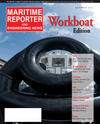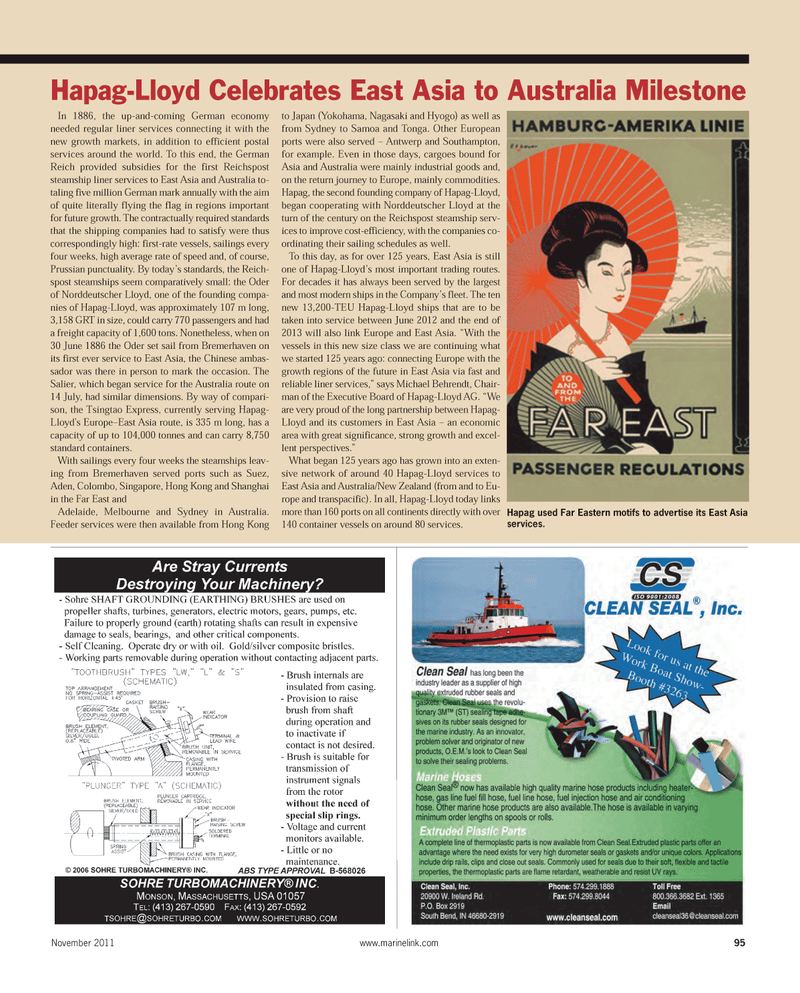
Page 95: of Maritime Reporter Magazine (November 2011)
Feature: Workboat Annual
Read this page in Pdf, Flash or Html5 edition of November 2011 Maritime Reporter Magazine
November 2011www.marinelink.com 95In 1886, the up-and-coming German economyneeded regular liner services connecting it with the new growth markets, in addition to efficient postal services around the world. To this end, the German Reich provided subsidies for the first Reichspost steamship liner services to East Asia and Australia to- taling five million German mark annually with the aim of quite literally flying the flag in regions important for future growth. The contractually required standards that the shipping companies had to satisfy were thuscorrespondingly high: first-rate vessels, sailings every four weeks, high average rate of speed and, of course, Prussian punctuality. By today?s standards, the Reich- spost steamships seem comparatively small: the Oder of Norddeutscher Lloyd, one of the founding compa- nies of Hapag-Lloyd, was approximately 107 m long, 3,158 GRT in size, could carry 770 passengers and had a freight capacity of 1,600 tons. Nonetheless, when on30 June 1886 the Oder set sail from Bremerhaven on its first ever service to East Asia, the Chinese ambas- sador was there in person to mark the occasion. The Salier, which began service for the Australia route on 14 July, had similar dimensions. By way of compari- son, the Tsingtao Express, currently serving Hapag- Lloyd's Europe?East Asia route, is 335 m long, has a capacity of up to 104,000 tonnes and can carry 8,750standard containers.With sailings every four weeks the steamships leav- ing from Bremerhaven served ports such as Suez, Aden, Colombo, Singapore, Hong Kong and Shanghai in the Far East and Adelaide, Melbourne and Sydney in Australia. Feeder services were then available from Hong Kong to Japan (Yokohama, Nagasaki and Hyogo) as well as from Sydney to Samoa and Tonga. Other European ports were also served ? Antwerp and Southampton, for example. Even in those days, cargoes bound for Asia and Australia were mainly industrial goods and, on the return journey to Europe, mainly commodities. Hapag, the second founding company of Hapag-Lloyd, began cooperating with Norddeutscher Lloyd at the turn of the century on the Reichspost steamship serv-ices to improve cost-efficiency, with the companies co- ordinating their sailing schedules as well.To this day, as for over 125 years, East Asia is still one of Hapag-Lloyd?s most important trading routes. For decades it has always been served by the largest and most modern ships in the Company?s fleet. The ten new 13,200-TEU Hapag-Lloyd ships that are to be taken into service between June 2012 and the end of 2013 will also link Europe and East Asia. ?With the vessels in this new size class we are continuing what we started 125 years ago: connecting Europe with thegrowth regions of the future in East Asia via fast and reliable liner services,? says Michael Behrendt, Chair- man of the Executive Board of Hapag-Lloyd AG. ?We are very proud of the long partnership between Hapag- Lloyd and its customers in East Asia ? an economic area with great significance, strong growth and excel- lent perspectives.? What began 125 years ago has grown into an exten- sive network of around 40 Hapag-Lloyd services to East Asia and Australia/New Zealand (from and to Eu- rope and transpacific). In all, Hapag-Lloyd today links more than 160 ports on all continents directly with over 140 container vessels on around 80 services. Hapag-Lloyd Celebrates East Asia to Australia MilestoneHapag used Far Eastern motifs to advertise its East Asia services. MR Nov.11 # 12 (89-96):MR Template 11/4/2011 1:41 PM Page 95

 94
94

 96
96
